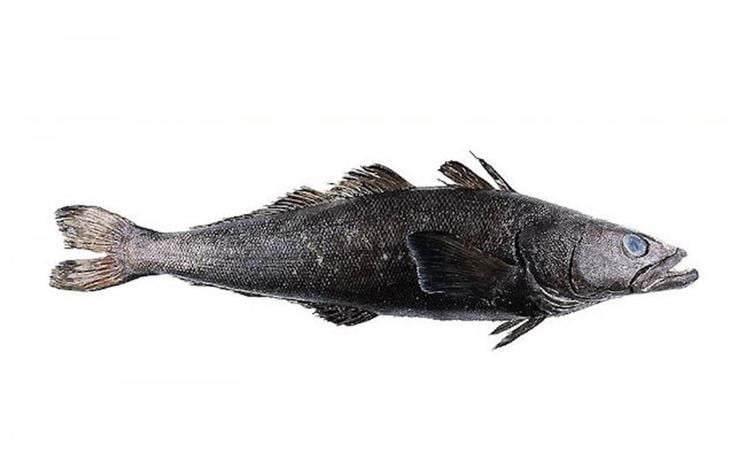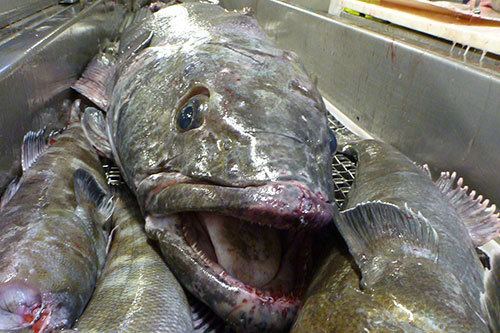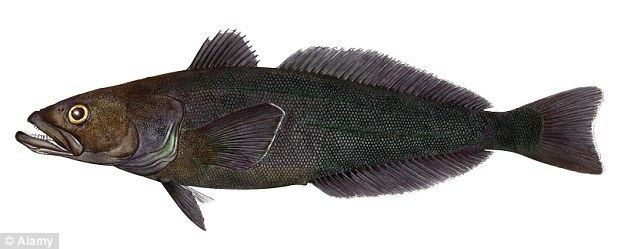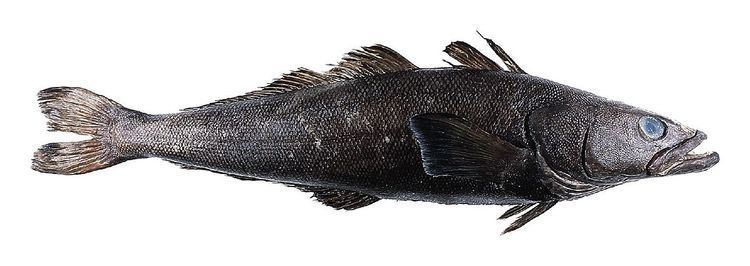Phylum Chordata Scientific name Dissostichus eleginoides Rank Species | ||
 | ||
Similar Bass, Sablefish, Yellowfin tuna, King crab, Crab cake | ||
Longlining for patagonian toothfish
The Patagonian toothfish, Dissostichus eleginoides, is a species of cod icefish found in cold waters (1–4 °C or 34–39 °F) between depths of 45 m (148 ft) and 3,850 m (12,631 ft) in the southern Atlantic, Pacific and Indian Oceans and Southern Ocean on seamounts and continental shelves around most sub-Antarctic islands.
Contents
- Longlining for patagonian toothfish
- Deep sea fish antarctic toothfish mero patagonian toothfish
- Name
- Ecology
- Management
- Compliance
- Legal fishing
- Illegal fishing
- Seafood chooser organizations
- References

A close relative, the Antarctic toothfish (Dissostichus mawsoni), is found farther south around the edges of the Antarctic shelf; and a Marine Stewardship Council (MSC) certified fishery is active in the Ross Sea.

The average weight of a commercially caught Patagonian toothfish is 7–10 kg (15–22 lb), depending on the fishery, with large adults occasionally exceeding 100 kilograms (220 lb). They are thought to live up to fifty years and to reach a length up to 2.3 m (7.5 ft). Several commercial fisheries exist for Patagonian toothfish which are detailed below.

Deep sea fish antarctic toothfish mero patagonian toothfish
Name

This species is also sold under the trade names Chilean Seabass in the United States and Canada; Merluza negra in Argentina, Peru and Uruguay; Legine australe in France; Mero in Korea, Japan, and Spain, and Bacalao de profundidad in Chile.

The name "Chilean Seabass" was invented by a fish wholesaler named Lee Lantz in 1977. He was looking for a name that would make it attractive to the American market. He considered "Pacific sea bass" and "South American sea bass" before settling on "Chilean sea bass". In 1994, the U.S. Food and Drug Administration (FDA) accepted "Chilean Seabass" as an "alternative market name" for Patagonian toothfish, and in 2013 for Antarctic toothfish.

In the UK, the approved commercial designations for D. eleginoides and D. mawsoni are "icefish" and "toothfish". This has created some confusion as there is a genuine "icefish" (Champsocephalus gunnari) caught in subantarctic waters, which does not resemble toothfish in any way.
Ecology
Patagonian toothfish spawn in deep water (around 1,000m) during the austral winter, producing pelagic eggs and larvae. Larvae switch to a demersal habitat at around 100m (1 year old) and inhabit relatively shallow water (<300m) until 6–7 years of age, when they begin a gradual migration into deeper water. As juveniles in shallow water, toothfish are primarily piscivorous, consuming the most abundant suitably sized local prey. With increasing size and habitat depth, the diet diversifies and includes more scavenging of squid, fish, and crustaceans. In turn, toothfish constitute a small part of the diets of sperm whales, southern elephant seals, and colossal squid.
As most toothfish fisheries are managed in accordance with CCAMLR regulations and conservation measures, it should be noted that CCAMLR adopts an “ecosystem approach” which requires that all other living resources of the Southern Ocean are treated as an integrated system where effects on predator, prey and related species are considered, and decisions on sustainable harvesting levels are made on the basis of sound, internationally peer reviewed scientific advice.
Management
Commercial fishing of toothfish is managed by the Commission for the Conservation of Antarctic Marine Living Resources (CCAMLR) inside the CCAMLR Convention Area which spans the Antarctic continent and waters between 45°S and 60°S. Some fisheries inside territorial waters within the Convention Area (e.g. Crozet Island, Prince Edwards and Marion Islands) are managed separately by countries with territorial waters taking CCAMLR management practices into account. Toothfish fisheries outside the CCAMLR Convention Area in the coastal waters of Argentina, Chile and Uruguay are managed by the relevant coastal state. However, these fisheries are still subject to the CCAMLR Catch Documentation Scheme (CDS) which tracks the trade of toothfish from the point of unloading to the point of final consumption.
In the legal toothfish fisheries managed by CCAMLR and countries with territorial waters, the most common method is fishing by longlines (where a long "mainline" is set in the water, with many baited hooks coming off that line). A small quantity of toothfish is caught by trawling (where a net is towed behind the boat for short periods of time). For all methods of legal fishing for toothfish, there are minimal interactions with, and risks to, seabirds. This is a result of requirements for legal operators to use mitigation devices or approaches such as:
In 2011 the CCAMLR Scientific Committee Chair, David Agnew, was quoted as saying “levels of seabird mortality are negligible in most areas”, with the one region yet to achieve these "near zero" results, having reduced seabird interactions by over 98% from their peak levels, and have continued to improve each year.
Trawling generally catches toothfish in the smaller size range, which requires calculations to be made at the annual stock assessment meetings of CCAMLR to take these catches of smaller sized fish into account, and lowers the overall available catch of toothfish by trawl. CCAMLR has prohibited all trawl fishing in high seas waters and exploratory fisheries.
Compliance
To minimise the risk of long-term adverse effects on target species, by-catch species and marine ecosystems, CCAMLR uses a number of compliance systems to monitor fishing activities in the Convention Area. This includes:
The Catch Documentation Scheme (CDS) for Patagonian toothfish (Dissostichus eleginoides) and Antarctic toothfish (Dissostichus mawsoni) was one measure that ensured reductions in illegal fishing for toothfish and reduced the scope for trade in illegally caught fish. The CDS is an innovative online catch document information system (DCD: Dissostichus Catch Document) developed to identify legal toothfish harvested, which tracks toothfish from the point of landing throughout the trade cycle to point of sale. The CDS requires verification and authorisation by national authorities at regular intervals in the trade cycle. Identification of the origin of toothfish entering the ports and markets of CDS Parties is essential.
Legal fishing
The Coalition of Legal Toothfish Operators, Inc. (COLTO) is a toothfish fishing industry body whose members represent over 90% of the legal toothfish catch worldwide. Six of the fisheries that are fished by COLTO members are now independently certified by the Marine Stewardship Council (MSC) as sustainable and well managed fisheries, and one more fishery (Crozet Islands, France: 3% of world catch) is currently undergoing full assessment against the independent MSC standards. Commercial fishing of Patagonian and Antarctic toothfish is managed by CCAMLR around most of the sub-Antarctic and Antarctic regions, however a fishery that lies within a nation’s Exclusive Economic Zone (EEZ) is managed by that nation, taking into account management recommendations and approaches by CCAMLR.
In 2004, the South Georgia toothfish fishery (CCAMLR Statistical Division 48.3) was the first toothfish fishery to be MSC certified, and was recertified in 2009 and 2014, as all MSC certified fisheries must be audited annually, and fully reassessed every five years. Currently, the South Georgia Total Allowable Catch (TAC) is 2,400t, and there are 6 longline vessels being operated by 4 companies in this fishery, which is managed by the UK overseas territory of South Georgia and the South Sandwich Islands.
The Ross Sea fishery (CCAMLR Statistical Division 88.1 and 88.2) was the second toothfish fishery to be independently evaluated and certified by the MSC as sustainable and well managed (in 2010). This fishery catches mainly Antarctic toothfish, a close relative to the Patagonian toothfish.
The Heard Island and McDonald Islands fishery (CCAMLR Statistical Division 58.5.2) was certified as a sustainable and well managed fishery by the MSC in March 2012 and is operated under Australian jurisdiction in a manner consistent with CCAMLR regulations. There are 6 vessels operated by 2 Australian companies (Austral Fisheries and Australian Longline). The CCAMLR determined TAC is 4,410t of toothfish for the 2014/15 season.
The Macquarie Island toothfish fishery is within the Australian EEZ, and is situated outside the CCAMLR Convention Area within FAO Statistical Area 81, though it is managed in a complementary way with the conservation measures adopted by CCAMLR. In May 2012, this was the fourth toothfish fishery to gain MSC certification. There are 2 Australian companies that are allocated to catch 410t of toothfish in 2014/15.
France regulates Patagonian toothfish in the waters surrounding the French islands in the South Indian Ocean, with scientific oversight from the National Museum of Natural History. These fisheries are located around the Kerguelen Islands (CCAMLR Statistical Division 58.5.1) and the Crozet Islands (CCAMLR Statistical Division 58.6). Fishing authorizations have been granted to six fishing companies based out of Reunion Island (before 1998, there had been agreements with other countries authorizing their ships to fish in these waters). The TAC for the Kerguelen Island fishery is 5,150t and was certified by the MSC in September 2013. The current TAC for the Crozet Islands fishery is 700t, and this fishery is currently under full assessment against the MSC standard.
The Falkland Islands, a self-governing British Overseas Territory, also has a toothfish fishery and was awarded MSC certification in 2014. The Falklands do not fall in the CCAMLR Convention area, though regulations on fishing methods, science and management mirror CCAMLR requirements. The TAC is currently 1,040t and is caught by a sole longline vessel.
Combined, over 60% of all legally harvested toothfish is independently assessed and certified by the MSC as being from sustainable and well managed fisheries.
The Chilean toothfish fishery is separated into two separate fleets. The "artisanal fleet" of small boats operates in the region north of 47°S inside the Chilean EEZ; and 6 vessels from the "industrial fleet" operate south of 47°S inside the Chilean EEZ as well as on the high seas both within and outside CCAMLR waters. The TAC for the industrial fleet is determined each year by the Chilean government based on biological studies carried out by both public and private scientific bodies. The current Chilean TAC for the industrial fleet is 1098t that is caught by 6 vessels from 3 companies. Since 2006, artisanal fleet catches have fluctuated between 2,091t and 1,558t per annum, but since 2014 have received a quota of 988t.
Argentina has a toothfish fishery off its coastline that is managed by the Argentine Federal Fisheries Council under recommendations from the National Fisheries Research Institute. This season the Argentine TAC is 3,700t that is caught by 6 vessels from 4 companies.
The Prince Edward and Marion Islands toothfish fishery is managed and regulated by Branch Fisheries, part of the South African Minister of Agriculture, Forestry and Fisheries. The South African Marine Resource Authorities fully supports and follows all CCAMLR Conservation Measures. The current TAC is 575t and is fished by two vessels belonging to two fishing companies/cooperatives, with catches having been restricted significantly following excessive illegal, unreported and unregulated (IUU) fishing in those waters in the late 1990s. TACs from this fishery have slowly started to increase as the stock begins to recover.
The total allowable catch of toothfish worldwide is around 25,600t in 2014/15, with 90% of this coming from COLTO members, and 60% of the total catch (15,327 tonnes) now being independently certified as coming from sustainable and well managed fisheries by the Marine Stewardship Council (with one other fishery totalling 700 tonnes under full MSC assessment).
Illegal fishing
In the late 1990s to early 2000s, illegal, unreported and unregulated fishing (IUU) for toothfish nearly collapsed some fisheries in the Southern Ocean. Though, since 2005, thanks to CCAMLR Member nations, government patrol vessels, NGOs, media exposure and a trade and port state measures, IUU fishing has been all but eliminated from within countries' exclusive economic zones, though a relatively small portion of IUU fishing still occurs in high seas areas.
At the peak of IUU fishing, illegal catches were estimated to be 32,000 tonnes in 1997 with approximately 55 vessels believed to be active. By 2010, IUU catches had fallen to an estimated 1,615 tonnes, all taken in high seas areas, with just four IUU fishing vessels reported to be active. This is a decrease in IUU fishing by over 95% since the mid 1990s. CCAMLR estimates that 90% of IUU catches are now of Antarctic toothfish, not Patagonian toothfish.
CCAMLR annually reviews information on IUU fishing activities in the Convention Area and has established a Contracting Party and a Non-Contracting Party IUU Vessel List (CCAMLR Conservation Measure 10-06 and Conservation Measure 10-07). Vessels included on the IUU Vessel Lists have engaged in IUU activities in the Convention Area and undermined the effectiveness of conservation measures, thereby threatening toothfish stocks, marine habitats and by-catch species. Vessels are included on the IUU Vessel Lists after a consensus decision from the Commission based on set criteria. This measure, combined with additional surveillance by member nations, catch documentation schemes has played a significant part in the reduction of IUU fishing for toothfish.
In the past, France sold some fishing rights to Japanese and other foreign fisheries, but because of IUU fishing, rights are now reserved for French fishers based at Réunion Island. Because of previous poaching, the French Navy and Australian Customs vessels still work in concert, patrolling both French and Australian EEZs, having made numerous arrests and seizures in the late 1990s to early 2000s. An Australian Customs vessel, the Southern Supporter, was involved in the renowned chase and apprehension of an IUU vessel in the 2003 Viarsa incident that stretched over 7,200 kilometers.
TACs for legal operators in CCAMLR are set, taking into account the estimated IUU catches from past years, and any current IUU activity that may be occurring in the different fisheries. In some fisheries this has meant a considerable reduction in legal catches – an example of this is the Australian Heard Island and McDonald Islands fishery, where the legal TAC was 3,800t in 1996/97. This was dropped to a minimum of 2,427t by 2006/07 with a substantial portion of that decline attributed to the IUU catches taken from the fishery between 1996 and 2002. Since then there has been zero IUU fishing in that fishery, and the legal TAC has steadily increased to its current 4,410t for the 2014/15 season.
In addition to the Catch Documentation System mentioned above, USA regulations do not allow toothfish imports without valid Dissostichus Catch Documents; and dealer permit and pre-approval certificates issued in advance by NOAA. In addition, toothfish must be caught from vessels equipped with satellite-linked automated VMS that track vessel movements from port-to-port to ensure compliance with set quotas and boundaries. All vessel VMS data must be reported to the centralized CCAMLR system, with confirmation to USA required that it has occurred, in order for any products from those boats to be imported into the United States.
As revealed by the "Black spider memos", Charles, Prince of Wales was worried about the future for the species. An open reply noted that sea birds had indeed been protected in toothfish fisheries globally, and that IUU fishing was virtually eliminated.
The EU has also imposed requirements against IUU fishing that include:
It is estimated by CCAMLR that around 5% of the worldwide toothfish catch is taken by IUU operators, and that product does not have the current Catch Documentation System evidence trail associated with it, so cannot be sold legally into major markets including USA, EU, and Japan.
In 2014 and 2015 there were several major campaigns to eliminate IUU fishing for toothfish. This included a Sea Shepherd campaign, Operation Icefish, which pursued one of the vessels, the Thunder, for 110 days before it was scuttled. Operations by the Royal New Zealand Navy, the Royal Australian Navy, Interpol, and governments of Spain, Thailand, Malaysia and Indonesia all combined to successfully apprehend, arrest and prosecute all of the remaining 6 IUU vessels fishing illegally for toothfish on the high seas.
Seafood chooser organizations
Patagonian Toothfish is currently listed by the Monterey Bay Aquarium on its Seafood Watch list and pocket guides. In April 2013, Seafood Watch produced an updated report, indicating new ratings for some fisheries, which allocates approximately 78% of toothfish caught worldwide, which are as follows:
In 2010, Greenpeace International added the Patagonian toothfish to its seafood red list. "The Greenpeace International seafood red list is a list of fish that are commonly sold in supermarkets around the world, and which have a very high risk of being sourced from unsustainable fisheries."
